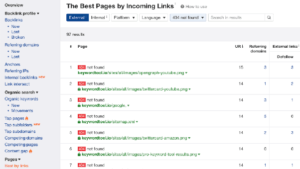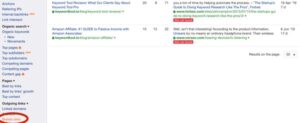1. Internal Links
The easiest way to gain backlinks is probably to link to your own content. While you are writing a new blog post, you can simply link to other related content of yours. Of course, those links need to make sense and add value for the user, meaning that those links should lead to helpful additional information. By doing so, you get additional links but also ensure a longer dwell time on your blog, and an increased user engagement.
However, keep it moderate. Too many internal links may cause your website to seem spammy, so make sure to only include internal links when it adds value to the user.
2. Backlink Poaching (Learn From Your Competitors)
Even if you created great high-quality content, you may be observing low traffic to your website. You might be struggling to find sites that are willing to give you backlinks, but there are lots of websites out there that will be willing to link to your web content. In fact, there are many sites that are already linking to content similar to yours, so they would probably be willing to link to your content as well, right? You can easily find those websites that might be interested in linking to your page by analyzing you competitor’s backlink profiles with tools like Ahrefs or Semrush. Check out the following steps to find out how to do so with Ahrefs!
Step 1: Search for competitors who have similar content or target similar keywords. Let’s assume that we are targeting the keyword: ‘keyword tool’.
Step 2: Use Ahrefs to check which websites are linking to your competitors. On the ‘site explorer’ tab on the top of the page, search by typing the domain name of your competitor’s website or product. Go to the ‘Backlink profile’ section, then click ‘Backlinks’.
Step 3: You may set the Link type as ‘Dofollow’ to sort for only Dofollow backlinks. Further, you can sort for specific platforms and languages as well. This will be helpful if you only want backlinks from websites in specific languages, or only from specific platforms such as blogs or e-commerce websites.
Step 4: You can export and save the backlink list as an Excel file, and afterwards you can sort and filter according to your liking. Finally, select those sites that you want to contact.
Step 5: Contact those websites that are linking to your competitors, and ask them if they would be willing to link to your high-quality content as well.
Remember that you want to have backlinks from websites with a high domain ranking, since those backlinks will increase your chances on ranking higher the most.
3. Replace Broken Links
When browsing through the web and clicking on hyperlinks, you may stumble upon some 404 errors.
404 errors occur when pages that a user wants to access no longer exist or can’t be found. Those 404 errors, or broken links, are a great opportunity to earn some backlinks for your content.
So, if you find broken links that were originally linking to content that is similar to yours, take that chance! Let the website owner know about that broken link, and ask them if they would be willing to replace that broken link with a link to your own high quality content. Since 404 errors are not good in regard of user experience, website owners will be more inclined to exchange a broken link with a link to your content.
You can use Ahrefs’ Broken links function to find broken links from your competitors. Go to the ‘Outgoing links’ section, then click ‘Broken links’.


Or, on Site explorer tab, go to ‘Pages’, ‘Best by Links’ and filter for HTTP 404 errors.
Then, Check the ‘Referring Domains’. There will be a list of webpages that provide broken links to your competitor’s pages.
After you found a broken link that is supposed to link content that is similar to yours, you can contact the owner of that website that has the broken link. Hopefully, the owner of that website will be happy to change the broken link to a link directing to your content, and there you go, one more backlink!
Want to know more about how to build backlinks, Check out this super helpful article on backlink-building.